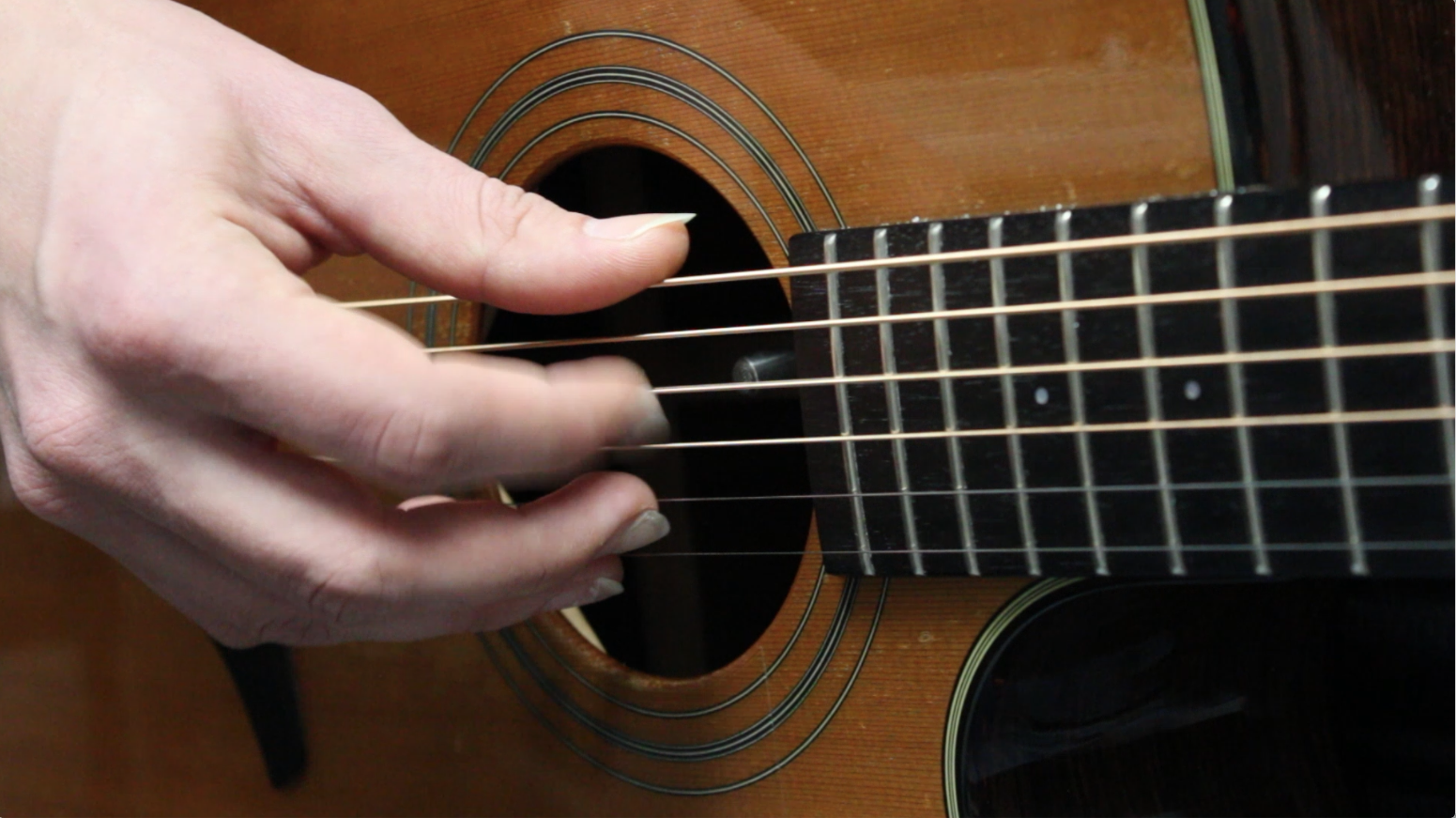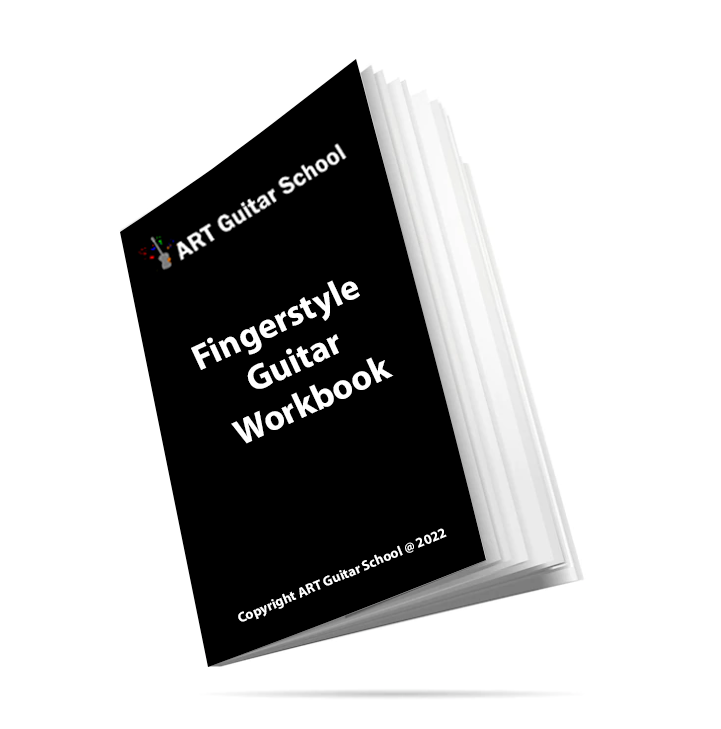FINGERPICKING KEY

The right hand:
P = Thumb
I = Index
M = Middle
A = Ring
Fingerpicking Pattern No. 1
This is the most essential fingerpicking pattern to start with. It requires no left hand chord or fretted notes. It is used in many popular fingerpicking songs and some songs are slight variations of this same pattern.
We have all open strings being plucked in sequential order. Each note is a quarter note in duration and will last exactly one second each if played at 60bpm.
Lets get to playing!
We will pluck each open string in order starting from the 6th string (Low E) and ending on the 1st (High E).
Step 1. Lets start with thumb (p) and pluck the 6th-4th string
Step 2. Pluck index (i), middle (m) and ring (a) on the 3rd-1st strings.

Here is a video demonstration of the finger picking pattern:
If you were having trouble please contact us and we will help you!
FOLLOW US ON
Get our FREE Fingerstyle Workbook!
RELATED BLOG POSTS
The Best Fingerstyle Guitar Songs for Beginners
Fingerstyle guitar is a beautiful and expressive technique, and many iconic songs can help beginners develop their skills. Whether you’re just starting out or have been playing for a while, learning beginner-friendly fingerstyle songs is a great way to build muscle memory, develop your finger independence, and deepen your understanding of rhythm and melody. Below are some of the best fingerstyle guitar songs for beginners.
1. “Blackbird” by The Beatles
“Blackbird” is one of the most popular fingerstyle songs for guitarists. This classic by The Beatles uses a simple yet effective fingerpicking pattern that alternates between the thumb and fingers. The melody is played on the higher strings while the thumb maintains a steady bass line on the lower strings. The song’s structure is straightforward, but the combination of bass and melody makes it a perfect challenge for beginners looking to improve their fingerstyle technique.
2. “Dust in the Wind” by Kansas
“Dust in the Wind” is another iconic song that incorporates fingerpicking. The pattern uses an alternating thumb with index and middle fingers playing the higher strings. The song’s gentle rhythm and simple chord structure make it a great starting point for beginners who are just learning how to play fingerstyle. The repetitive nature of the picking pattern helps build muscle memory while providing a rewarding piece to play once mastered.
3. “Fast Car” by Tracy Chapman
This song is a great choice for beginners because it features a repetitive, easy-to-learn fingerpicking pattern. The fingerstyle pattern alternates between the bass and melody, and the song itself has a laid-back feel that lets beginners focus on their technique. The simplicity of the chords and picking pattern allows for more focus on developing accuracy and timing.
4. “Tears in Heaven” by Eric Clapton
“Tears in Heaven” is an emotionally powerful ballad that’s perfect for beginners who want to add some expressive depth to their playing. The song’s fingerstyle pattern isn’t overly complicated but incorporates some subtle variations that make it a beautiful piece to learn. It also helps beginners practice transitioning between chords smoothly while maintaining steady rhythm.
5. “Hey There Delilah” by Plain White T’s
“Hey There Delilah” is a soft, melodic song that features a simple and repetitive fingerstyle picking pattern. The song’s easy-to-follow chord structure and calm tempo make it a good choice for beginners who want to build their fingerpicking technique. As you progress, you can experiment with adding dynamics and accents to give the piece more character.
6. “The Boxer” by Simon & Garfunkel
“The Boxer” uses a combination of bass lines and melody played simultaneously, which makes it an excellent piece for developing fingerstyle skills. The song features a repetitive pattern with a clear, rhythmic thumb-and-finger alternating style. The key challenge for beginners is maintaining a steady rhythm throughout the song, which will improve finger independence and coordination.
7. “Wonderful Tonight” by Eric Clapton
Another Eric Clapton classic, “Wonderful Tonight,” is a simple song that incorporates an easy fingerpicking pattern. The melody is gentle, and the chords are straightforward, allowing beginners to focus on finger control and the smooth transition between bass and melody notes. The slow tempo and repetitive nature of the song make it a great choice for those just starting out with fingerstyle guitar.
8. “Little Lion Man” by Mumford & Sons
“Little Lion Man” is an upbeat and fun song to play that uses a combination of strumming and fingerpicking. The fingerpicking pattern is relatively simple, and the rhythm is easy to follow. The song’s folk vibe makes it perfect for developing both your strumming and picking technique in a single piece.
9. “Hallelujah” by Leonard Cohen (covered by Jeff Buckley)
“Hallelujah” is a beautiful and soulful song that can be played using fingerstyle guitar. The chord structure is simple, and the fingerpicking pattern is gentle and flowing, making it an ideal choice for beginners. The song’s simplicity also allows you to focus on adding emotional depth to your performance, making it a great piece to master as you advance.
10. “River Flows in You” by Yiruma
This modern piece by Yiruma is a favorite among beginners who are interested in learning fingerstyle with a more classical or contemporary twist. The piece uses a mixture of repeating patterns and arpeggios, making it both challenging and rewarding. The flowing, melodic lines are great for building control over finger placement and dynamics.
Conclusion
Learning fingerstyle guitar can be incredibly rewarding, especially when you start playing iconic and beautiful songs. These ten songs are perfect for beginners who want to develop their fingerpicking skills. By practicing these pieces, you’ll not only improve your technique but also gain a deeper appreciation for the versatility and beauty of fingerstyle guitar. Choose a song that resonates with you, and enjoy the process of learning and refining your skills.
How to Choose the Right Guitar for Fingerstyle Playing
When it comes to fingerstyle guitar, choosing the right instrument is crucial to achieving the best sound and feel for your playing style. Fingerstyle playing requires precision and clarity, and the right guitar can enhance both the technical and tonal aspects of your performance. Here’s a guide to help you choose the perfect guitar for fingerstyle playing.
1. Acoustic vs. Electric
While electric guitars can certainly be used for fingerstyle playing, most fingerstyle guitarists prefer acoustic guitars for their rich tonal qualities and natural resonance. Acoustic guitars provide a fuller, more organic sound, which is important when playing intricate melodies and harmonies simultaneously.
2. Guitar Body Shape and Size
The size and shape of the guitar body have a significant impact on the tone. Larger-bodied guitars, like the dreadnought or jumbo, typically produce a fuller, louder sound, which can be beneficial if you’re playing in a larger room or need strong projection. However, smaller-bodied guitars like concert, parlor, or auditorium models offer greater clarity and are often preferred by fingerstyle players for their more defined tones and responsiveness to lighter touch.
3. Wood Type
The type of wood used in the construction of the guitar plays a critical role in the overall sound. Spruce is a common top wood for acoustic guitars, as it provides clarity, brightness, and a balanced tone. Cedar is another popular choice for fingerstyle players, known for its warm, rich tone with less brightness than spruce. For the back and sides, rosewood and mahogany are common choices. Rosewood provides deep resonance and complex overtones, while mahogany offers a warmer, more focused tone.
4. Neck Profile and Action
A guitar with a comfortable neck profile is important for fingerstyle playing, as you’ll be doing a lot of intricate finger movements. Look for a guitar with a slimmer neck that allows your fingers to move freely between the strings. The action (the height of the strings above the fretboard) should also be set up for easy playability. A lower action is generally preferred for fingerstyle, as it reduces the effort needed to press down the strings and allows for more precise control.
5. String Gauge
When choosing a guitar for fingerstyle, the gauge of the strings you use can impact your sound. Lighter gauge strings (like .010-.047) are easier on the fingers and allow for quicker, more delicate picking. Heavier gauge strings (like .012-.054) provide more resistance, which can lead to a fuller tone but may require more finger strength and control.
6. Tonal Considerations
Fingerstyle guitarists often seek a balanced tonal range, with clear bass notes and shimmering treble. Therefore, it’s important to test guitars for their ability to produce clear, articulate sounds across all frequencies. A guitar that produces well-defined bass notes without muddying the higher frequencies is ideal for fingerstyle playing.
7. Playability
Ultimately, the playability of the guitar is paramount. A guitar that feels comfortable and easy to play will encourage you to practice more and develop your skills faster. When trying out guitars, pay attention to the response of the strings to your touch, the comfort of the neck, and how easily you can play different chords and fingerpicking patterns.
Conclusion
Choosing the right guitar for fingerstyle playing depends on a combination of tonal preferences, playability, and body style. While there’s no one-size-fits-all solution, selecting a guitar with the right features for your playing style will greatly enhance your fingerstyle experience. Don’t hesitate to try out several guitars before making your decision, and choose one that feels natural and inspiring to play.
Top 10 Fingerstyle Guitar Exercises for Mastery
Fingerstyle guitar is a technique that requires both precision and creativity. To master fingerstyle guitar, consistent practice and the right exercises are essential. In this post, we will explore the top 10 exercises that will help you build strength, accuracy, and fluidity in your fingerstyle playing.
1. Basic Fingerpicking Pattern
Start with the most fundamental fingerpicking pattern: thumb on the bass string, followed by your index, middle, and ring fingers on the higher strings. Practice this basic alternating pattern on a C chord, ensuring that your thumb maintains a steady rhythm and your fingers move fluidly.
2. Travis Picking
Travis picking is a classic fingerstyle pattern that involves alternating bass notes with melody notes. Begin with a simple Travis picking exercise on the C chord, where your thumb alternates between the bass strings, and your fingers pick the melody notes. This pattern is used in many fingerstyle songs.
3. Arpeggio Practice
Arpeggios are a staple in fingerstyle playing. Practice plucking each note of a chord individually, starting with a simple C major chord. Move your fingers sequentially across the strings: thumb (bass), index (third string), middle (second string), and ring (first string). Aim for smooth, even timing.
4. Finger Independence Drills
Building finger independence is crucial for fingerstyle guitar. Practice exercises where each finger plays independently, such as alternating between your thumb and index, thumb and middle, etc. This will help develop control and improve your overall dexterity.
5. Hammer-ons and Pull-offs
Incorporate hammer-ons and pull-offs into your fingerstyle practice. Start with simple two-note phrases, and gradually build up to more complex patterns. These techniques can add expressiveness to your playing, allowing for smoother transitions and more musical phrasing.
6. Scale Practice with Fingerstyle
Practice scales using your fingers instead of a pick. Start with a simple major scale and pluck each note with a different finger (thumb for bass, index for middle strings, and so on). This exercise builds coordination and helps you internalize the notes on the fretboard.
7. Thumb and Finger Sync
This exercise focuses on synchronizing your thumb and fingers to work together fluidly. Practice playing a note with your thumb and then immediately with your index or middle finger. This will help you develop even rhythm and enhance your overall fingerstyle technique.
8. Chord Progression Practice
Practice basic chord progressions (e.g., G, C, D) while using fingerstyle techniques. Focus on making smooth transitions between chords while maintaining steady rhythm with your thumb. This exercise is a great way to combine both rhythm and melody in your playing.
9. Speed Building Exercises
To increase your fingerpicking speed, practice slow exercises and gradually increase the tempo. Start with a simple 4/4 pattern and increase the speed over time. Keep your movements relaxed and avoid tension as you build speed.
10. Adding Dynamics and Expression
Once you’re comfortable with basic exercises, try adding dynamics (volume control) to your playing. Play the same exercise but experiment with playing some notes softly and others more loudly. This adds musicality and emotion to your fingerstyle pieces.
Conclusion
With consistent practice, these exercises will help you develop the technical skills necessary for mastering fingerstyle guitar. Stay focused, be patient, and enjoy the process of building your fingerstyle expertise. Whether you’re a beginner or advancing to more complex techniques, these exercises will guide you toward becoming a proficient fingerstyle guitarist.




0 Comments